
Girls in STEM: A cause for celebration, not complacency
GCSE and A level results give grounds to rejoice about girls’ success in STEM subjects, but there is a long way to go before gender imbalance in the sciences is undone, writes Jo Foster.
No matter your background, location or interests, we’ve all come to appreciate how important science is in our lives over the past two years. More than that, high-profile scientists such as Professor Sarah Gilbert, the creator of the AstraZeneca vaccine have set fantastic recent examples of how the historic gender imbalance in STEM can be overcome.
And this week’s exam results provide more grounds for hope that we are making progress in addressing this imbalance. Tuesday’s A-level results revealed entries in the sciences were up 6.4 per cent on 2020, and Thursday’s GCSE results showed further encouraging signs. Girls are outperforming boys this year in physics, chemistry and biology.
But while this looks like great news at first glance, we mustn’t become complacent. This year has been anything but business as usual. It would be naive to believe that this could not have led to differences in outcomes for boys and girls.
For example, evidence from Ofqual suggests a slight bias in favour of girls when examined by teacher assessment and it has been long established that girls generally do better in coursework-type assessment. This year and last, it is likely that the emphasis on teacher assessment and more fluid assessment methods have led to more favourable outcomes for girls than boys across GCSE subjects, not just in science.
And even though we are seeing increases in the numbers of girls choosing STEM subjects at A-level, there are still considerably fewer girls studying physics than boys. The increasing success of girls in GCSE science may lead to more of them choosing to pursue these subjects further, but it remains to be seen.
Meanwhile, despite years of interventions to encourage women into STEM careers, the gender difference within the workforce remains consistent across age groups; 29 per cent of 16–29-year-olds in STEM are women, and 28 per cent of 30–49-year-olds.
So it’s all the more important that we capitalise and build on this year’s good news. Those same girls who have succeeded so well in their science studies must be supported and inspired to go on to become the next generation of scientists.
We know it is important for girls to encounter examples of women who have succeeded in STEM careers for them to choose the same. And equally important is providing young people with opportunities to take part in and experience real research. Teaching science without it is like teaching football and never allowing the aspiring players onto the pitch.
Teaching science without research is like teaching football without a pitch.
Real science, the science that led to the development of the Covid-19 vaccinations, is a creative and exciting endeavour. Science is dynamic and developing. It’s research, the joining together of disciplines and creating something new.
We know from our research that carrying out real science research as part of the curriculum is motivational for students and teachers alike. It increases their enjoyment and makes young people more determined to pursue a career in STEM. For girls, experiencing real science in action, and working with women in a research career as part of a project is life-changing.
This week, there is reason for hope that this year’s results will translate into increased uptake from these successful girls. But as we leave the pandemic behind and a return to formal exams looks likely, we must redouble our efforts to ensure the momentum generated by this year’s results is carried forward.
Let’s celebrate this positive news and learn from what works for girls. Let’s make as big a deal of Sarah Gilbert as we do of England captain, Steph Houghton in our school displays and assemblies. Let’s look at how we assess the sciences throughout young people’s school careers to build their confidence in preparation for their final exams. And let’s enrich our curriculum with opportunities for real research.
Because without these girls, the government has one hand tied behind its back in delivering its ambition to make the UK a science superpower.